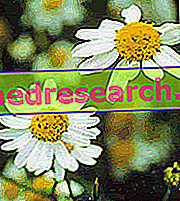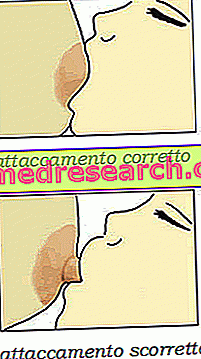Chamomilla recutita (L.) Rausch. (Matricaria camomilla L.)
Fam. Asteraceae (Compositae)
Tubuliflorae
Br. Matricaire chamomile
Ing. German chamomile
Sp. Manzanilla alemana
Ted. Kamille
Description
Chamomile is a herbaceous plant, annual, 20-50 cm high with erect bearing and thin stem, fasciculata root; sessile leaves, bipennatosette, divided into thin lacinias.
Flower head inflorescences, united in corymbs, carried by a long peduncle. The flower heads have a diameter of 10-17 mm and have an envelope made up of 12-17 bracts and a receptacle of hemispherical or conical shape, glabrous and hollow inside (difference from the Roman chamomile), which gives the internal disk a a certain convexity. The flower heads have yellow, tubular, hermaphroditic flowers in the center and white, ligulate, feminine flowers in a distal position.
Each tubular flower has a yellow corolla that divides itself terminally into 5 teeth, and presents 5 singenese and inferior ovary stamens with only one basal ovum. The ligule of the white distal flowers is divided into 3 terminal teeth.
It flowers from May to August
The fruit is a very small, sub-cylindrical, slightly curved and yellowish achene, with the convex dorsal face and the ventral face with 3-5 longitudinal ribs. The seeds are without endosperm. Pappus absent. It has a very characteristic, penetrating and bitter taste.

Areal
Chamomile is native to Europe, not very common at altitudes above 300-400 m above sea level. It is common in sown and orchards, but it is also cultivated
Culture
Chamomile is grown mainly in Germany, Hungary, Yugoslavia, the Soviet Union, Egypt, Argentina, as well as in several other European countries. Despite being an annual plant, the crop can last from 3 to 7 years, due to the heads remaining on the plant which, by disseminating, spontaneously perpetuate the species. The plant is normally carried out in the summer by distributing "spreading" on well leveled and chopped soil, 1-2 Kg / ha of seed mixed with inert material of similar granulometry and specific weight (wood sawdust).
Early sowing (July) gives better results than late and very precocious ones (spring, this is not recommended because a possible summer drought would negatively affect the survival of the young chamomile seedlings).
Density: optimal is the plant of 20-25 plants per m2.
Since the seed is small, it is inadvisable to land it after sowing (to avoid secondary dormancy and emergencies), but also too superficial distribution, which favors the loss of seed by the wind.
Today for the chamomile the sowing technique is used with rows spaced 30-35 cm; the advantages are the use of smaller quantities of seed, have more uniform plants and finally, using special seeders equipped with small toothed rollers, make the contact of the "seed" more intimate with the ground, thus reducing the likelihood of movement by the wind .
Growing requirements: not very demanding from the nutritional point of view: the ordinary technique does not in fact require fertilizing on soils with average fertility. The intake of potassium in particular seems to be harmful because it would reduce the content in essential oil. Chamomile is abundant in strong, dry and stony soils, but it adapts badly to acid soils on which it produces a poor essence. It tolerates saline soils and vegetates moderately in the presence of high pH (9).
Adversity: do not cause great concern, even if the chamomile is attacked by various parasites.
Mushrooms: Alternaria spp, which attacks the leaves, Peronospora leptosperma, which damages the entire aerial part, Fusarium spp, which attacks the root apparatusInsects: lepidoptera, Cucullia chamomillae Schiffe C.artemisiae Hufn., Whose larvae damage the flower heads, Emitteri, as Aphis fabae Scop., Brachicaudus helichrysi Kalt. and B.cardui, which cause damage to leaves and stems, Eterottero, Nysius minor Dall., which attacks the flower heads, a leaf miner, Autographia chryson Esqr, a beetle, Stegibium paniceum L., which damages the preserved flower heads, Aphids, which can be controlled with phosphoric esters or with specific aphids.
Weeds: various herbicides can be used both for sowing and post-emergence.
In some cases herbicide residues have been found on the herbalist material, in particular phenoxy derivatives, the use of which is therefore inadvisable.
Drug
The dried chamomile flower heads, containing an essential oil with alpha-bisabolol, camazulene, farnesene, apigenin, flavones, coumarins.
uses
In dietary products: in liqueur.
Chamomile in herbal medicine and herbal medicine: as spasmolytic (aqueous extract in the form of baths and infusions), anti-inflammatory and antibacterial (especially alcoholic extract). In Italy it is also used as a mild sedative to combat insomnia and anxiety, in the treatment of gastrointestinal diseases, stomatitis and dermatitis, gynecological and pediatric uses.
The chamomile flower head contains an essential oil, the azulene with sedative action of the central nervous system, and a diciclic ether that has an antispasmodic action on the digestive system. Chamomile also has a healing and emmenagogue action.
In cosmetics, chamomile is used for various skin treatments due to the calming and anti-inflammatory action against the epidermis, due to mucilage and to lighten hair.
A handkerchief soaked in cold chamomile buffed on the eyelids upon awakening is an excellent remedy to reduce the swelling of dark circles.



